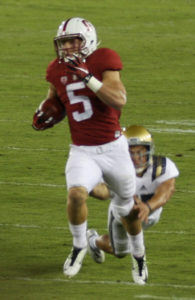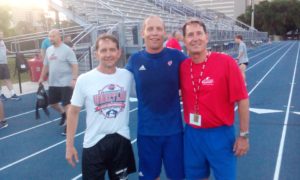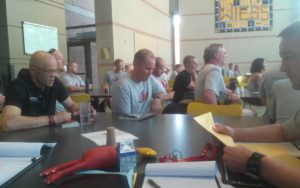7 Sports Science Myths: Dr Michael Joyner (Mayo clinic)
Leave a CommentGAIN reflections
Dr Mike Joyner is a faculty member of the Mayo clinic specialising in human performance physiology.
I met him early on the Wednesday morning when he was attempting to roll around on the floor and get up despite his very long levers. What impressed me was his effort and concentration in attempting a new task, no matter how difficult.
We then had a great conversation over breakfast about long term athlete development, fundamental tumbling skills and education for those from a less than ideal background. Fuelled by his enthusiasm and some pancakes and coffee, I was primed to learn his thoughts on sports science.
Here is a summary of his key points
- Lactic Acid Makes Me Sore. Lactic acid is removed in 40/50 minutes post exercise. Active recovery does help this process, but ALL lactic acid is gone within 24 hours. Soreness after training is due to muscle damage.
- Sports drink and glucose are necessary. There is no effect of glucose ingestion until after 60 minutes on steady state exercise. Longer duration bouts of exercise may require some. There are many different variables including; the duration and intensity of the bout factors, and the nutritional status before exercise.
Most studies are conducted early in the morning when the athletes are fasted, so extrapolating this to afternoon exercise may be tenuous. The 2% reduction in bodyweight due to dehydration DOES impact performance, so hydration matters. Rinsing out the mouth with sugar can affect performance positively: it is like “brain candy”.
- It must be genetic. Size is the obvious example where genetics matter (I would say gender matters more) but there are only a few examples of what Dr Joyner calls “O. Athletes” (Knockout).
An example of breeding would be Christian McCaffrey (drafted by Carolina Panthers) whose dad was Ed McCaffrey (Giants, 49ers, Broncos) and his maternal grandfather was Dave Sime who was an Olympic silver medallist in the 100m in 1960.
Otherwise, studies have found little evidence for a “talent gene” except for some with ACTN3 and ACE genotypes for speed. There is no evidence for gene testing in young people to “predict talent”.
Dr Joyner said there is a lot of “lazy thinking” about genetics. He then showed a slide with the headline “There are more mile/ 1500m world record holders from Kansas than Kenya”!
The DNA variables would need to explain: Energy systems, muscle fibre type, superior coordination, body composition, motivation, psychology and trainability. They would NOT explain social factors.
- To stretch or not to stretch? There is a vast amount of evidence on this, and it is all contexts specific. I made the point that a lot of the studies are asking the wrong question. “Does stretching before exercise prevent injury?” and then tested on military recruits before doing a 20 mile route march with kit in boots. Stretching is obviously the least important factor in that context.
- Altitude Training. The 1968 Olympics played a key role in the development of this research as for the first time athletes would be competing at altitude on a big scale. There is a need to compare the short vs long term effects due to the initial reduction in training quality.
Dr Joyner says the data on Live High- Train Low is “all over the place”. The long term effects of living at altitude are an increase in lung capacity. But, you have to keep the training quality up. Those who used altitude training successfully did a lot of short intervals to maintain quality.
Some key points he asked us to consider were:
Beware of individual variation; more is not always better; give it time to work; beware of effects on intensity training and volume; recovery is sometimes affected due to a reduction in sleep quality.
- My programme is better than your programme! Dr Joyner showed a video clip of one of the Olympic middle distance races (forget which) where the top 3 finishers were very close. All 3 of those runners followed very different training programmes: high mileage or high intensity intervals and so on. Yet, all 3 were effective.
The idea that one programme is inherently better than another is flawed. In strength training research it isn’t so much the number of sets vs reps it’s the training to failure that is important. As long as intensity is involved, gains will be made in strength.
Dr Joyner then showed video clips from the “Miracles of Men” ESPN documentary of the Soviet Ice Hockey team doing some very basic “old school” training in a gym. The imagination and variety of exercises was novel but the players were working hard too. (This clip can also be seen in the Red Army documentary on Netflix).
He also showed the clip of the La Sierra High School training programme of the 1960s
and what 15 minutes a day can do to form the foundation that is lacking in today’s youth.
- Today’s athletes are better. More people are competing today, with better financial incentives, so records tend to fall. Doping has also had an impact on some performances too.
However, some of yesteryear’s performances were pretty impressive. Don Lash, in the 1930s, set the 2 mile record of 8:58.4 on a weekly mileage total of 25 miles.
This comparison of Andre DeGrass vs Jesse Owens shows the difference in track and shoes between 1936 and 2011
Dr Joyner also showed how innovation changed standard practices and protocols. Everyone knows about Dick Fosbury, but at the same time Debbie Brill, a 13 year old girl, was doing the same technique. Both of them were able to try this because of better landing surfaces on the other side of the bar.
Summary
In the discussion that followed Dr Joyner summarised with “Get kids out, have fun, spend time with good coaches”. (That sounds a lot like what we are trying to do at Excelsior ADC).
This was a refreshing and engaging discussion, which I have only briefly touched upon. I spoke to Dr Joyner about academics preaching to each other from Ivory Towers without actually coming into contact with real people in the real world. He said “That’s why I practice Medicine one day a week, so I stay in touch”.





